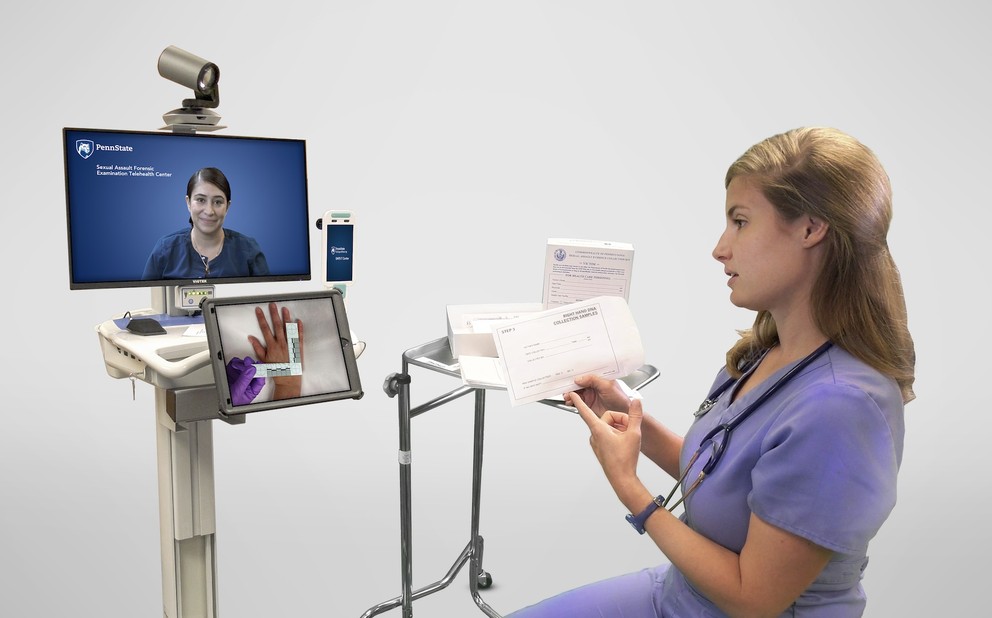
Penn State’s Sexual Assault Forensic Examination Telehealth (SAFE-T) Center has been utilizing telehealth along with a community-engaged solution to enhance sexual assault care in rural and underserved communities in Pennsylvania. Now, its researchers are providing a guide to help others interested in creating similar programs.
According to experts, nearly 1 in 3 women and 1 in 4 men experience some form of sexual violence in their lifetime. Due to a national shortage of sexual assault nurse examiners — or SANEs, registered nurses who are specially trained to respond to sexual assault — communities often struggle to provide survivors with the specialized care they need.
This disparity of sexual assault care is especially felt in rural and underserved communities. Telehealth has been utilized in other health care arenas, and has been proven effective for sexual assault care, but a detailed roadmap of how to create a community-engaged telehealth response for sexual assault has not been available.
In a paper published in The Journal of Rural Health, the SAFE-T Center’s community-engaged telehealth model is laid out in detail focusing on the overall program design and implementation phases. Although Pennsylvania requires all hospitals to provide sexual assault care and mandates that each county has a victim advocacy establishment, there is no oversight to the quality of clinical care or on communication and coordination between law enforcement, victim advocacy, and sexual assault providers.
As a result, sexual assault responses — from initial medical care, ongoing survivor support, to judicial outcomes — vary widely across the commonwealth. One aim of the SAFE-T Center’s work is to gather community stakeholders, amplify the strengths of the communities, and provide resources and support to shore up gaps in the sexual assault response.
“It is important that our solution built upon community strengths, such as hospitals with supportive administrators that value enhancing their hospital’s sexual assault care and nurses who are passionate about this work,” said Sheridan Miyamoto, assistant professor of nursing and principal investigator of the SAFE-T Center. “If the individual community does not feel engaged in the solution it will not be as successful.”
The paper details steps in SAFE-T’s development and implementation phases, including identifying committed partner hospitals, assessing the problems with and disparities in sexual assault care, envisioning a solution that builds upon community strengths, and engaging with stakeholders and the community in improving sexual assault response locally.
The program’s design phase included delivering expert mentoring and quality assurance via telehealth technology, assembling an elite TeleSANE team, and developing the needed technology and care model.
During the planning phase, the SAFE-T IT team developed a vision for an easy-to-use, reliable, secure, fiscally responsible, sustainable, scalable system to perform telehealth consultations.
When a sexual assault victim arrives at one of the hospitals partnered with the SAFE-T Center, the patient can choose to consent to a telehealth consultation. Through specialized SAFE-T telehealth equipment a teleSANE is able to communicate directly with the nurse, the patient, and the victim advocate, who is often present to support the patient.
“This is a technically difficult examination,” said Miyamoto, who is also a cofunded faculty member in the Social Science Research Institute. “The experienced TeleSANEs — who have performed hundreds of examinations — act as a calming presence that gives the local nurse confidence that they won’t miss a step. This partnership sets the tone for trauma-informed care, emotional support, choice, and the patient regaining control though those choices.”
As the researchers continue to examine the short- and long-term health trajectories of the patients in SAFE-T Center partner hospitals, both nurses and patients have reported positive benefits from the program. Early results suggest that patients feel having the exam is the first step toward healing, and local-site nurses reported feeling supported through difficult cases by the TeleSANE and that without this support they may have stopped doing this work, Miaymoto said.
“Our paper includes critical steps in developing a community-engaged response to sexual assault,” said Miyamoto. “We designed the SAFE-T model to help people who experience sexual violence have access to expert care, no matter where they live. We hope that this model will provide a good starting point for others looking to do similar work.”
Other Penn State researchers involved in this work include Lorah Dorn, professor of nursing; Daniel F. Perkins, professor of family and youth resiliency and policy in the department of agricultural economics, sociology and education, principal scientist and founder of the Clearinghouse for Military Family Readiness in the Social Science Research Institute; Cynthia Bittner, SAFE-T Center project director; Dennis Scanlon, distinguished professor of health policy and administration; and Elizabeth Theide, graduate student in nursing.
The United States Department of Justice, Office for Victims of Crime, National Institutes of Health Kennedy Shriver National Institute of Child Health and Human Development, National Center for Advancing Translational Sciences, and National Institutes of Health supported this project.